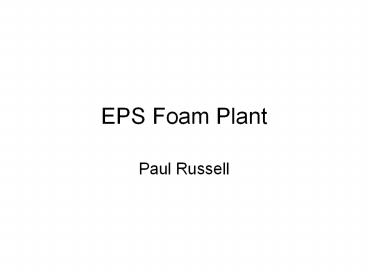EPS Foam Plant - PowerPoint PPT Presentation
Title:
EPS Foam Plant
Description:
EPS Foam Plant Paul Russell EPS Processing Pre-expansion The Pre-expansion phase of manufacturing is simply the swelling of the small bead to almost 50 times its ... – PowerPoint PPT presentation
Number of Views:697
Avg rating:3.0/5.0
Title: EPS Foam Plant
1
EPS Foam Plant
- Paul Russell
2
EPS Processing
- Pre-expansion
- The Pre-expansion phase of manufacturing is
simply the swelling of the small bead to almost
50 times its original size through heating and
rapid release of the gas from the bead during its
glass transition phase. - Aging
- After the expanded beads have been dried they are
blown into large open storage bags for the aging
process. The beads have been under a dynamic
physical transformation that has left them with
an internal vacuum in the millions of cells
created. - The Molding Process
- After the aging is finished, the beads are then
ready for molding into blocks. Since this is a
confined environments, the only way the beads can
expand is to fill up any voids between them
causing the soft surfaces to fuse together into a
polyhedral type solid structure. - Shape molding machines
- Expanded bead fills the mold cavity via pneumatic
filling tubes. The mould walls are also equipped
with holes to connect the mold with the steam
chamber. Steam is applied to the EPS bead filled
cavity of the mold. The steam causes the beads to
soften again and to expand. The expansion
pressure (around 1 bar) compresses the beads
against each other and at the same time forces
them against the mold walls so that they fuse
together. The resultant part is then cooled by
spraying water onto the mould and by applying a
vacuum. When cooled down sufficiently, the final
molded part can be taken from the mould. - Curing
- Heating curing is the next step of our process.
This not only accelerates the curing process of
the freshly molded blocks, but also assure that
the material is dimensionally stable and provides
a completely, dry material for best fabrication
results.
3
Material Ingredients
lt0.1 Rest-Monomer
100
6 Pentane
80
60
93.9 PS
40
20
0
EPS
4
- Infrastructure - 2.0 million (boiler, pipes,
material storage, pentane destruction,
drying/curing ovens) - Molding Machines between 200,000 - 400,000
each, - Operating the plant unless you have about the
equivalent of 500,000/month in coolers being
produced the plant wont make money.
http//usa.foameps.com/english/layout.asp
5
Typical EPS Molder Plant (Base-Functions)
Example Revenue 20 Million Employees
150 Size 30.000 m² Machines 38 EPS 8
EPP Annual Weights 3500 tons EPS, 400 tons
EPP Others approx. 30 Mio. Parts/Year, 720.000
m³ Volume
6
Pre-expander
7
Principle of Bead Expansion and Bead-Fusion
Theoretical shape of a bead, cut at the end of an
extruder (at raw-material vendors like BASF). The
extruder is permanently pressing the hot, liquid
and pressurized mixture of polystyrene and liquid
PENTANE in cooling channels, in which the
material is cooling down and turning into solid
spaghetti, then cut into little cylinder shaped
pieces. The gas Pentane is thereby kept in the
solid PS and cannot expand, only if the PS is
softened by the impact of heat.
Soft and partially melted beads are sticking
together.
The impact of heat is softening the rubber ball
allowing the spring to expand. The happens as
well in the pre-expander and later again within
the tool. Pre-expansion is required, because the
tiny raw-material pieces would cause problems in
the material injection process.
To explain the principle a compressed spring
inside a rubber-ball
8
Pre-Expansion Process
afterwards up to 3 days intermediate storage in
cotton-silos. Not the raw-material, but mainly
the pre-expansion process defines the later
material-density (only EPS, not EPP)
Pre-expander (batch)
9
Aging process
10
ABs Tool, the Part, Molding
AB-cushion
AB-owned Tool
11
Molding Process Steps
Ejector
Water-spayers
Fill-Injector
Tool
Tool-Support-Beams
Steam-Chamber moving
Steam-Chamber fixed
12
(No Transcript)
13
(No Transcript)
14
Ejector
Water-spayers
Fill-Injector
Tool
Tool-Support-Beams
Steam-Chamber fixed
Steam-Chamber moving
15
Ejector
Water-spayers
Fill-Injector
Tool
Tool-Support-Beams
Steam-Chamber fixed
Steam-Chamber moving
16
(No Transcript)
17
(No Transcript)
18
(No Transcript)
19
Molding
20
Possible Tool-Layouts
Break line, approx. 9 mm wide (usually not
containing cooling functionality)
Min-distance 20 mm for cooling
L
R
R
4 Cavities, 2 Set Tool
2 Cavities, 1 Set Tool
8 Cavities, 4 Set Tool
8 Cavities, 4 Set Tool, separated in 2 x 2 Sets,
which can be operated separately, interesting for
tool-changes during product lifetime.
6 Cavities, Sets not connected by a break-line






























